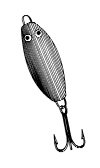The water is cold, the bite is off, and none of your hot spots are working. The bass have started to suspend off of deep structure, and you've tossed your entire tackle box at them, a shoe, a 9/16th wrench, and the leftover beefsticks from last week's fishing trip. You may as well pack it up, head home, and see if there's a race on, because those fish aren't going to be caught...or are they?
Too many times I've found myself leaning on the side of my boat, rod in hand, and only 6" of line extending from the tip of the pole to my jig. There it skates back and forth across the top of the lifeless water. Back-and-forth, back-and-forth, as my cheek sinks deeper into my head-supporting clenched hand. "Oh where, oh where have the little fish gone? Oh where, oh where can they be?" C'mon, you know you've sung that before! Don't deny it - we all have. It's these sort of days that make me want to take up backgammon - someone always wins, and no one gets a fish hook to the back of the head (well, not usually). But backgammon tends to bore me, so instead I retool my game, think like a fish, and reach for a jigging spoon, a lure just as productive as it is uncommon.
When using jigging spoons in deep water, your fish locator becomes almost as important as the lure itself. Look for suspended fish near steep breaks, or hovering over deep structure. When I say deep, I mean anything in the neighborhood of 20-40 feet. Once you've found the stacked fish, it's a good idea to toss out a buoy to mark their location. You'll be working that spot repeatedly and reduntantly. Try your best to maintain position with your trolling motor. If need be, and you have one available, chuck an anchor over the side to hold your spot. If an anchor isn't available, look to a fishing buddy telling the same old, tired fishing stories. He'll make a fine anchor.
With tired, old fishing buddy anchored down, it's time to jig some spoons. This process will be unique to many bass fisherman, both novice and expert, as our usual role is to cast and retrieve, covering a lot of water in a short amount of time. Walleye fisherman, on the other hand, will find the technique quite akin to their usual toothy fish approach. There is still quite a bit of water covered in jigging spoons, but it's all right below your boat, and you won't be casting. Instead, let the spoon free fall about a foot or two below the suspended fish, while keeping some tension on the line. The jigging spoon puts on its best presentation on it's way down, mimicking a wounded baitfish. Once your spoon has settled, wait a moment, and then give your rod a big rip, moving your rod tip from about 8:00 to darn near 12:00. Immediately let the lure fall back down, twisting and turning as it slips through the strike zone for a second time. I can't think of anything that would better entice a cold-day lazy fish to strike. Repeating this process, and keeping the lure in the strike zone, you're almost guaranteed a strike.
 Most of those strikes are going to come as the lure reaches the high point of the rip. Just before the spoon starts its fall back down, a hawg is going to wrap it's big lips around your lure, but detecting the strike is often difficult. One of my favorite jigging spoon quotes comes from Jimmy Houston. "It's been said by many tournament fisherman that jigging spoons are the most difficult baits in the world to learn to master. The strike by the bass usually feels as if you are pulling your bait through molasses. When it feels like Aunt Jemima just grabbed it, jerk! You probably got a bass!"
Most of those strikes are going to come as the lure reaches the high point of the rip. Just before the spoon starts its fall back down, a hawg is going to wrap it's big lips around your lure, but detecting the strike is often difficult. One of my favorite jigging spoon quotes comes from Jimmy Houston. "It's been said by many tournament fisherman that jigging spoons are the most difficult baits in the world to learn to master. The strike by the bass usually feels as if you are pulling your bait through molasses. When it feels like Aunt Jemima just grabbed it, jerk! You probably got a bass!"
It's true! I can't count the number of fish I've missed when I was first learning to use the jigging spoon. I'd attribute most strikes to just weeds grabbing hold of the spoon's treble hook. All it feels like when the fish grabs hold is that the lure slowed down. There's no tapping like there is when fishing plastics; there's no wicked thud and run at the end of your line like a crankbait strike - no, this is simply a slowing down of the lure, almost as if it's running through thick goo. Be sensitive to this, and remember that if you think it might be a fish then you should set the hook. No one will have an opportunity to laugh at you if it's not - you can just say you were trying a new ripping technique.
Cold water temps? Don't pack up and head home! Instead, reach for a jigging spoon. Find the suspended fish, work the spoon throughout the vertical strike zone, and you will turn those cold lake temps into some of your most productive fishing conditions.